Early German playing cards
Some early examples of popular German playing cards from the XV and XVI centuries.
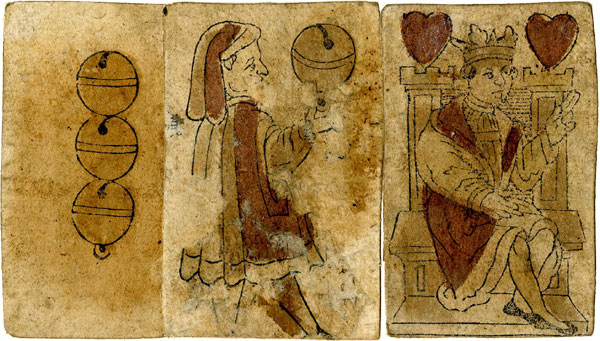
Above: 3 and over-knave of bells, king of hearts in the act of giving a blessing, hand-coloured woodcuts circa 1450-1500. © The Trustees of the British Museum • Museum number 1867,0309.292►
Playing cards arrived in Germany very soon after they first reached Europe in the last few decades of 14th century. Public demand required that affordable cards should be produced economically for ordinary folks - as opposed to the exquisite luxury packs made for the super-rich. The earliest German cards emanated from Frankfurt a/m, Munich, Nürnberg and Leipzig. Thus the humble form of popular medieval German playing cards was born - king, over-knave and under-knave with the suits of acorns and leaves growing from a central stem, whilst hearts and hawkbells are loose. Printed from woodblocks, coloured using stencils.
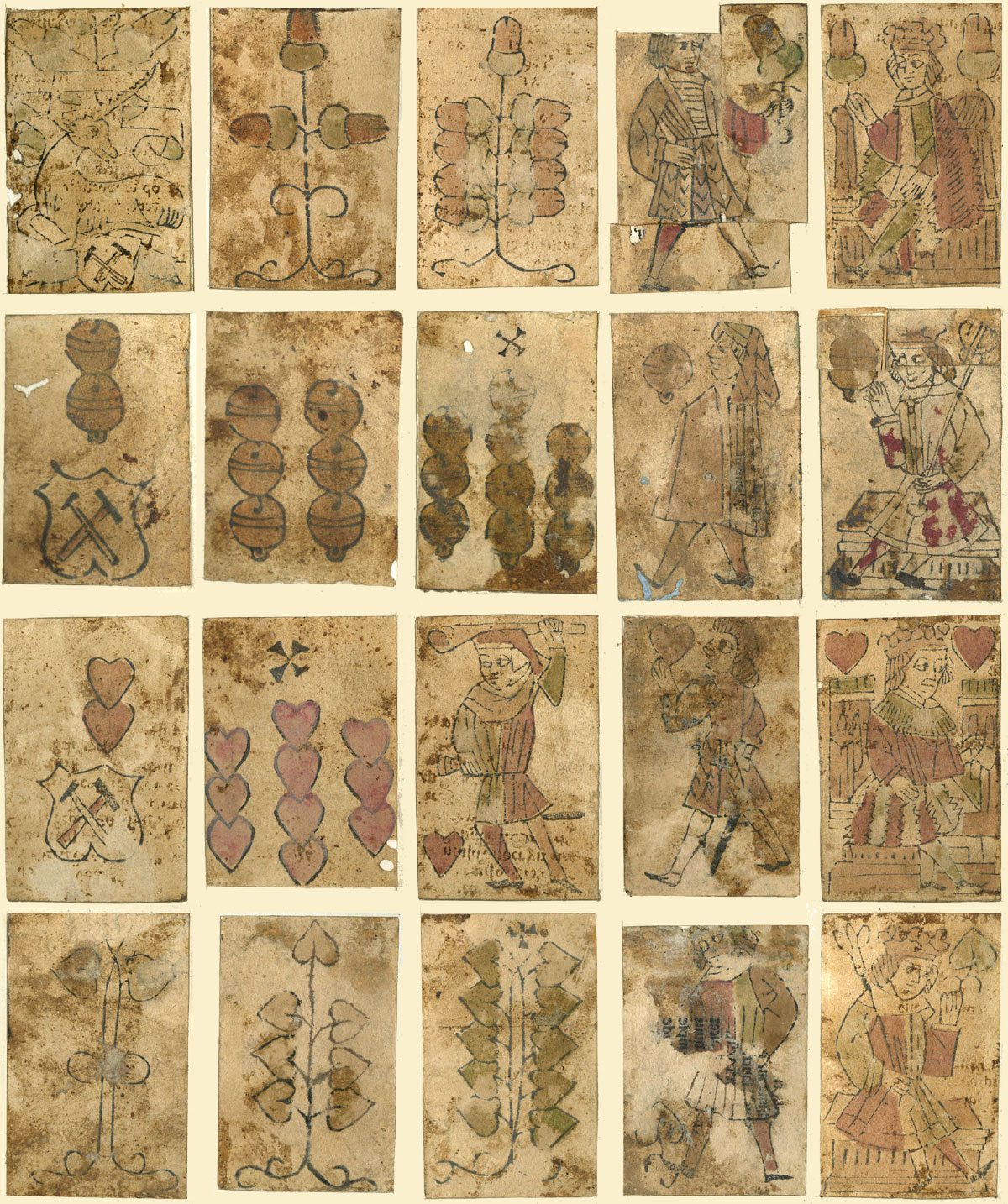
Above: Stukeley's Cards discovered as stiffener inside the two pieces of the cover of a fifteenth century book, total 48 cards: 2-10, lower knave, upper knave & king in each suit (i.e. no aces or queens). Manufacturer's device on the twos plus a unicorn on the two of acorns. © The Trustees of the British Museum • Stukeley's Cards►
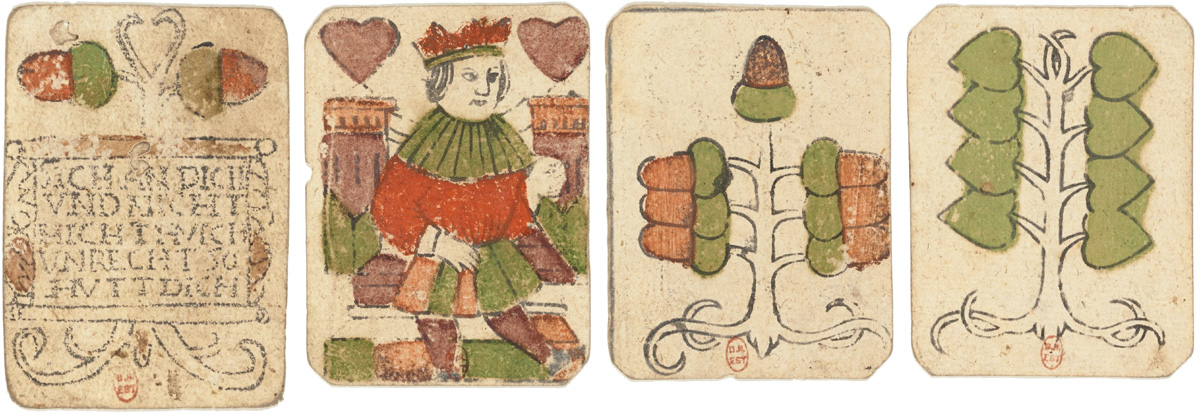
Above: cards from an incomplete set, stencil-coloured woodblocks, c.1500 or possibly earlier. The kinh of hearts is seen sitting on his throne. The two of leaves has the proverb "Ach an dich und nicht mich thu ich unrecht so hüte dich", popular motto which can be translated as "Take heed of yourself and not of me, and if I do wrong, be on your guard." It is very likely that this sentence will have its counterpart on another card (absent from this set), the continuation of the proverb reading: "Dann Glügselig ist der mann der sich vor schaden wahren kann". Source gallica.bnf.fr / Bibliothèque nationale de France • Cartes d'un jeu à enseignes allemandes 1500-1525►
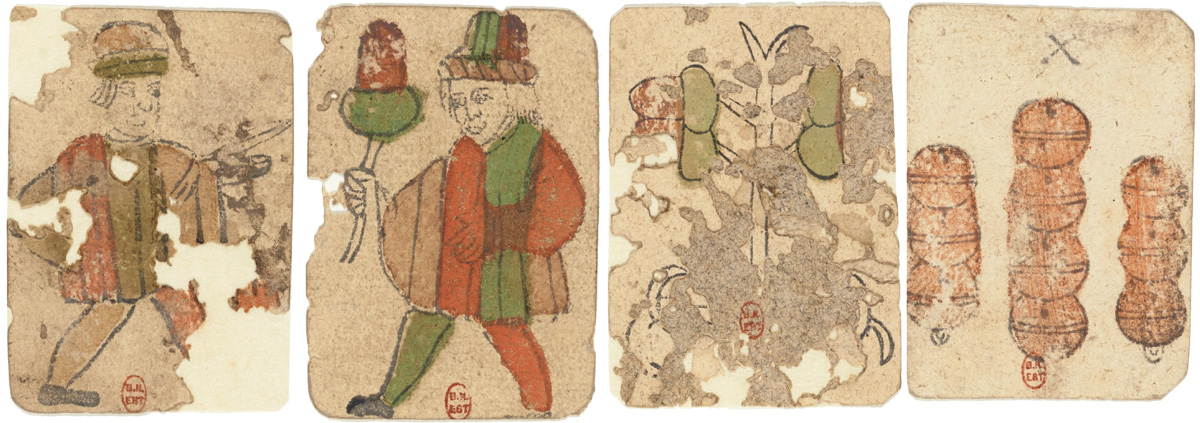
Above: 4 more early German-suited cards, c.1500-1525, with similar colour palette and technique to example shown above. The ten of bells shows ten hawkbells arranged in three columns. The difference between Ober and Unter can be judged from the position of the suitmark, high or low. Source gallica.bnf.fr / Bibliothèque nationale de France • Cartes d'un jeu à enseignes allemandes 1500-1525►
The “banner-10”
German and Swiss cardmakers often represented the 10 of each suit, not by a pip card with ten suit-signs, but by a card displaying a banner bearing a single suit-sign and sometimes a Roman X to indicate its rank.
The pip-cards were 2-9 plus the “banner-ten”. As there were no aces, this made a complete pack of 48 cards (the “banner-ten” is no longer used in Germany but can still be found in modern Swiss-suited packs).
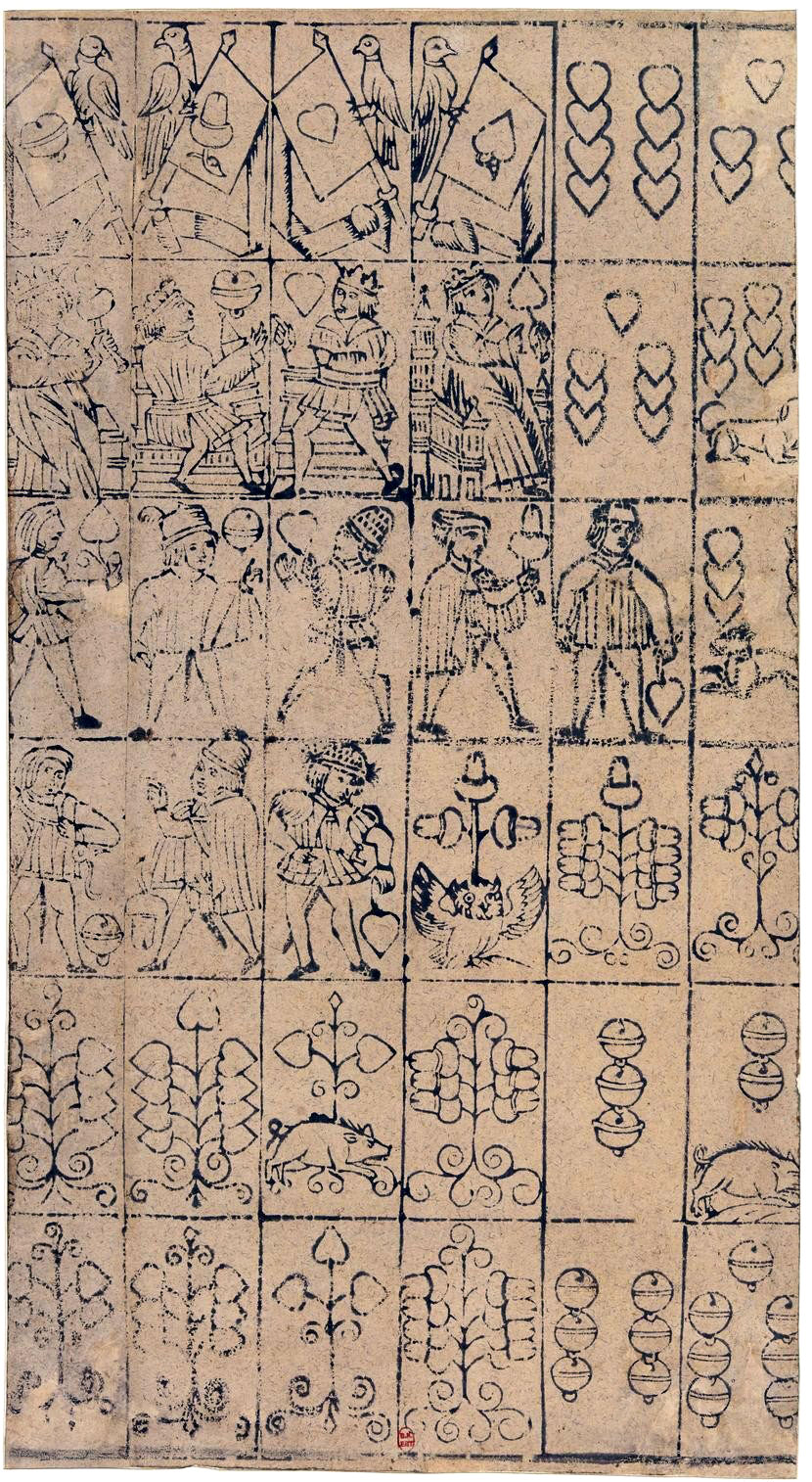
Above: uncut sheet of early German-suited playing cards of rudimentary quality, c.1500, with banner-10s, wild boars on the twos, an owl on the three of acorns, a dog on the six of hearts and a lion on the nine of hearts. © The Trustees of the British Museum.
There were plenty of skilled woodcutters, working in large or small workshops; different areas developed their own local varieties which led, over time, to emerging regional patterns. A degree of standardisation began to appear in the seventeenth century.
Some modern regional patterns, even though now they may be double-ended, still contain features or idiosyncrasies inherited from earlier days. This can be observed in the Bavarian and Franconian packs, also the Ansbach and Saxon patterns, for example.
References
O’Donoghue, Freeman M: Catalogue of the collection of playing cards bequeathed by Lady Charlotte Schreiber, Trustees of the British Museum, London, 1901 (German 1) [digital version here]
Willshire, W. H.: A Descriptive Catalogue of Playing and Other Cards in the British Museum, Trustees of the British Museum, 1876, reprint 1975. (German 124).
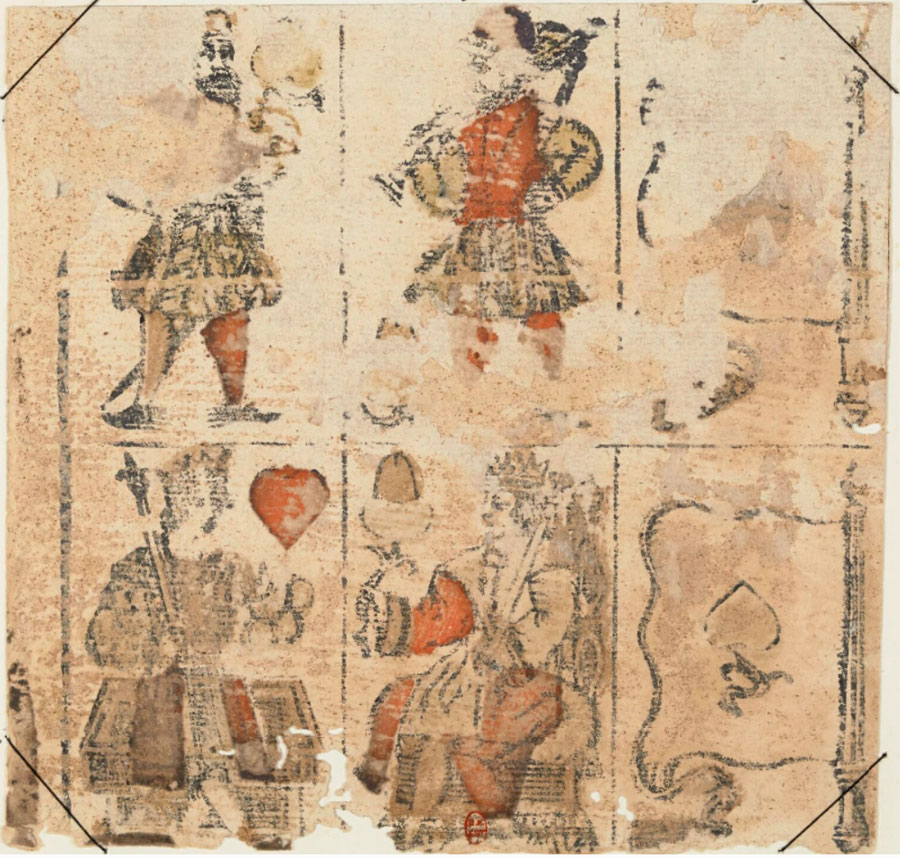
Above: fragment from an uncut sheet of German-suited cards, c.1500. We can see the kings seated on thrones, and also the banner-10s instead of ten separate symbols. The overall design shows some elaboration in the costumes as new poses evolve for the figures. Source gallica.bnf.fr / Bibliothèque nationale de France • Fragment de planche de cartes d'un jeu à enseignes allemandes►
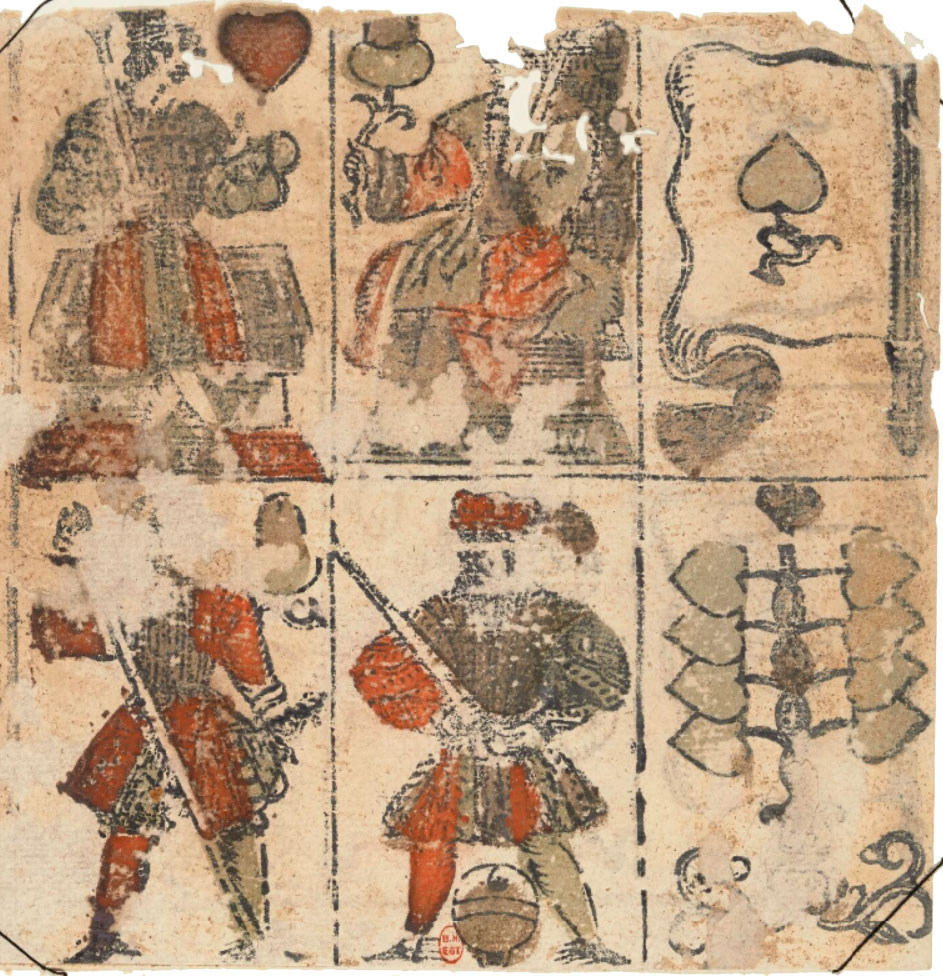
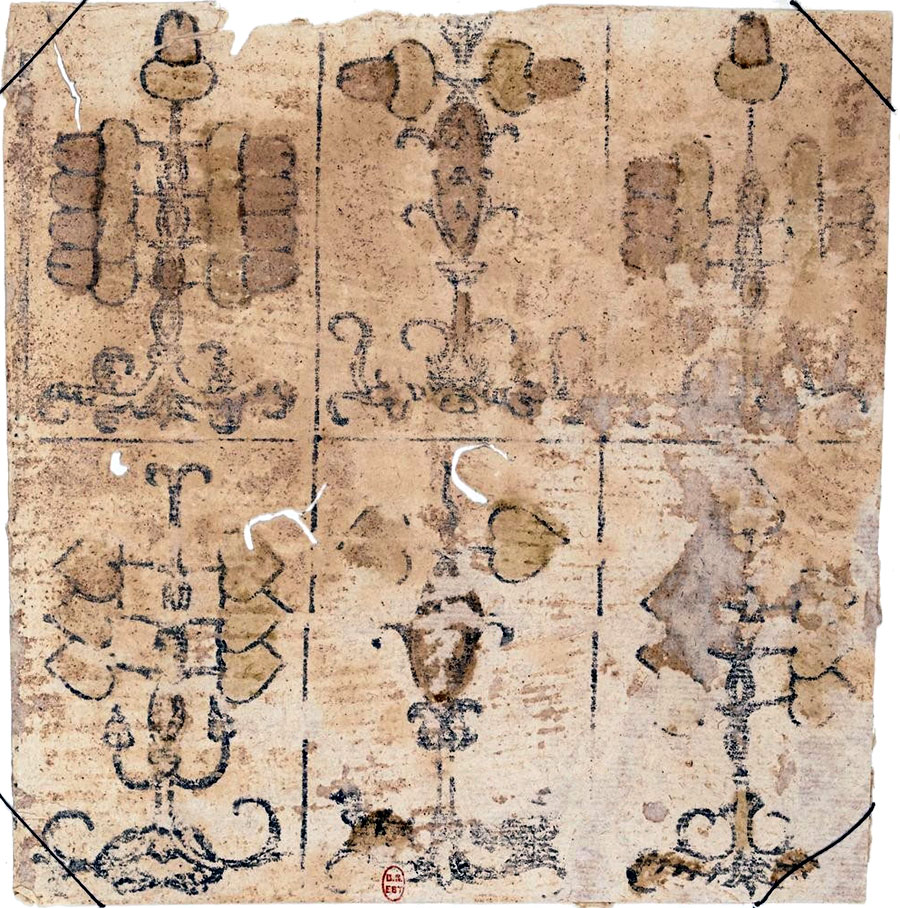
Above: fragment from an uncut sheet of German-suited cards, c.1500. Source gallica.bnf.fr / Bibliothèque nationale de France • Fragment de planche d'un jeu de cartes à enseignes allemandes, 1500-1525►
By Simon Wintle
Spain • Member since February 01, 1996 • Contact
I am the founder of The World of Playing Cards (est. 1996), a website dedicated to the history, artistry and cultural significance of playing cards and tarot. Over the years I have researched various areas of the subject, acquired and traded collections and contributed as a committee member of the IPCS and graphics editor of The Playing-Card journal. Having lived in Chile, England, Wales, and now Spain, these experiences have shaped my work and passion for playing cards. Amongst my achievements is producing a limited-edition replica of a 17th-century English pack using woodblocks and stencils—a labour of love. Today, the World of Playing Cards is a global collaborative project, with my son Adam serving as the technical driving force behind its development. His innovative efforts have helped shape the site into the thriving hub it is today. You are warmly invited to become a contributor and share your enthusiasm.

Leave a Reply
Your Name
Just nowRelated Articles
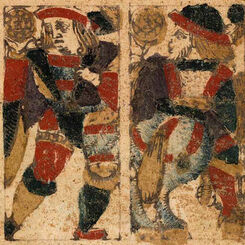
Toledo, 1584
Archaic Spanish-suited deck with 48 cards made in Toledo in 1584.
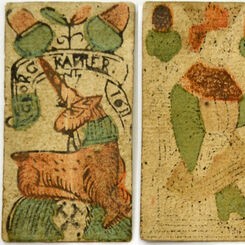
Georg Kapfler
Antique deck of old Bohemian playing cards of the German type manufactured by Georg Kapfler and date...
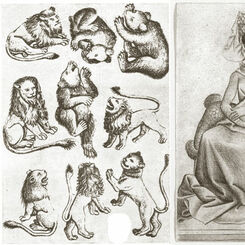
Master of the Playing Cards
Animal suited playing cards engraved by the Master of the Playing Cards, Germany, c.1455

Hans Sebald Beham
Playing cards designed by Hans Sebald Beham (1500–1550).

Old Bavarian pattern
Uncut sheets of playing cards of the Old Bavarian pattern by Michael Schatzberger, Passau, c.1780.
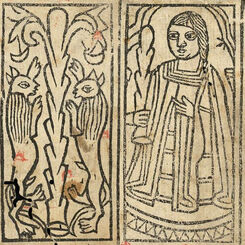
XV Century Catalan playing cards
XV Century Catalan Playing Cards, featuring four female Sotas, four Aces and four cards from the sui...
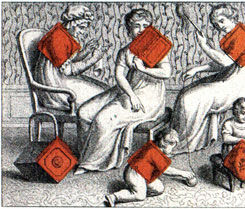
Cotta Transformation playing cards
In 1804, J.G. Cotta, a publisher and bookseller in Tübingen, Germany, produced the first set of tran...
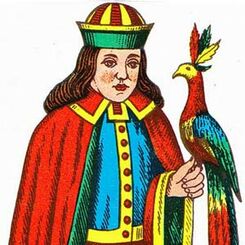
German Saxon Pattern
The German Saxon Pattern or “Schwerdter Karte”.
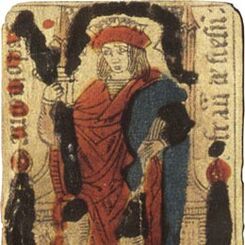
The Combination of Images and Text on early playing cards
When playing cards have titles or legends these reference a written/literary tradition of some form....
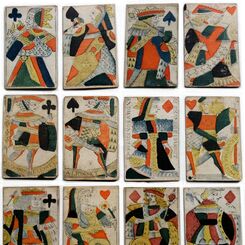
Provence Pattern - Portrait de Provence
The 'Provence' pattern contains figures which go back to the fifteenth century.

Malta
The so-called ‘Dragon Cards’, with winged monsters on the four Aces, are an enigmatic aspect of earl...
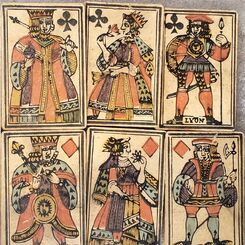
Lyon Pattern type iii
This pattern was used in various parts of eastern France but was ultimately replaced by the official...
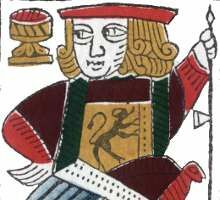
Navarra, XVII Century
Facsimile of 17th century Spanish-suited playing cards produced by Erregeak, Sormen S.A., Vitoria-Ga...

Prussian Pattern
Derived from Jagdkarten or Hunting cards with patriotic overtones and rural scenes as vignettes on t...
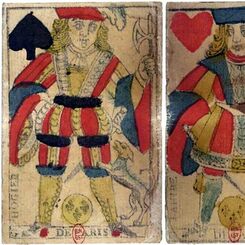
Paris Pattern
The Paris pattern was established as such around the middle of the seventeenth century (based, perha...
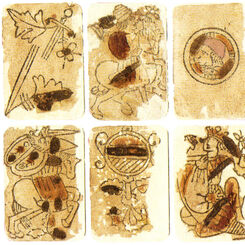
Baraja Morisca — Early XV century playing cards
Primitive Latin suited pack, dated by paper analysis as early XV century, which makes this one of th...
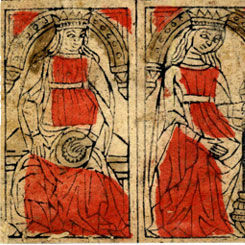
XV Century Italian Playing Cards
Cards from a pack of an early form of north Italian playing cards, with the swords back-to-back and ...
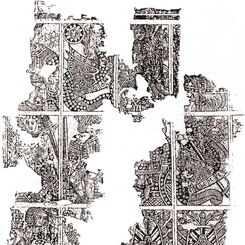
Early Spanish/Portuguese type
Fragment of a sheet of archaic Spanish-suited 'Dragon' playing cards found during restoration of a h...
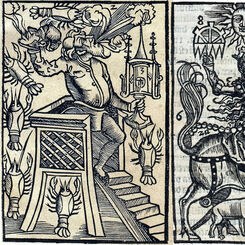
Logica Memorativa
Logica Memorativa playing cards by Thomas Murner, Brussels, 1507.

Playing cards in the Upper Rhine region
Documentary evidence suggests that card playing established itself in Italy in 1376, and then spread...
Most Popular
Our top articles from the past 60 days


 Your comment here. Your comment here. Your comment here. Your comment here. Your comment here. Your comment here. Your comment here. Your comment here. Your comment here. Your comment here. Your comment here. Your comment here. Your comment here. Your comment here. Your comment here. Your comment here. Your comment here. Your comment here. Your comment here. Your comment here. Your comment here. Your comment here. Your comment here. Your comment here. Your comment here. Your comment here. Your comment here. Your comment here. Your comment here. Your comment here. Your comment here. Your comment here.
Your comment here. Your comment here. Your comment here. Your comment here. Your comment here. Your comment here. Your comment here. Your comment here. Your comment here. Your comment here. Your comment here. Your comment here. Your comment here. Your comment here. Your comment here. Your comment here. Your comment here. Your comment here. Your comment here. Your comment here. Your comment here. Your comment here. Your comment here. Your comment here. Your comment here. Your comment here. Your comment here. Your comment here. Your comment here. Your comment here. Your comment here. Your comment here.




















